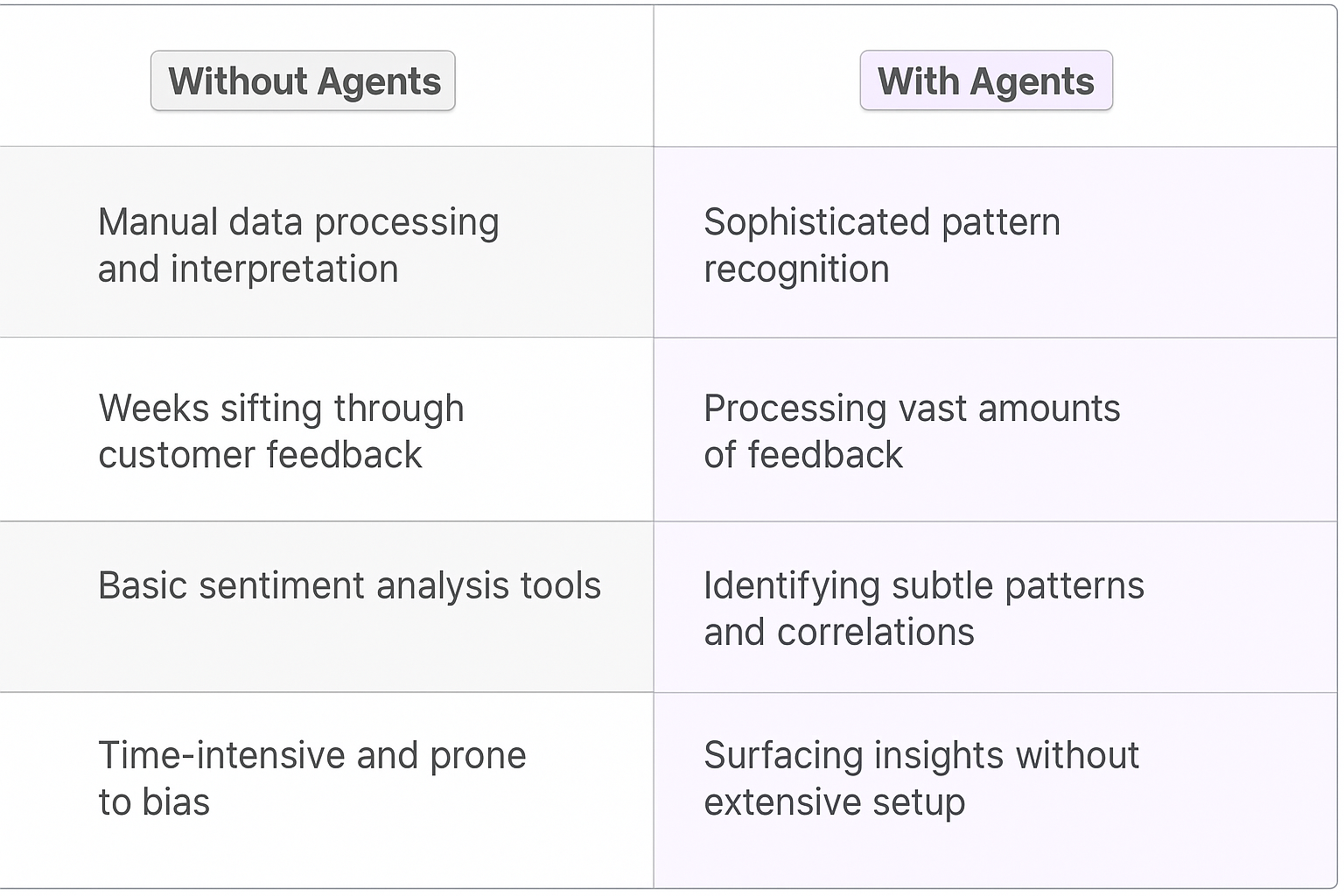Satisfaction Driver Analysis AI Agents
Understanding Satisfaction Driver Analysis Through AI
What is Satisfaction Driver Analysis?
Satisfaction Driver Analysis is a systematic approach to identifying and measuring the key factors that influence customer satisfaction. Through AI-powered analysis, organizations can now process massive amounts of unstructured feedback data to uncover the root causes of customer satisfaction and dissatisfaction. This analysis goes beyond surface-level metrics to reveal the complex interplay of factors that shape customer experience.
Key Features of Satisfaction Driver Analysis
- Real-time processing of customer feedback across multiple channels
- Pattern recognition in unstructured data
- Sentiment tracking with temporal and contextual awareness
- Automated categorization of feedback themes
- Predictive analytics for emerging satisfaction trends
- Cross-channel correlation of customer experiences
- Impact quantification of different satisfaction drivers

Benefits of AI Agents for Satisfaction Driver Analysis
What would have been used before AI Agents?
Traditional satisfaction analysis relied heavily on manual data processing and interpretation. Product teams would spend weeks sifting through customer feedback, survey responses, and support tickets. They'd use basic sentiment analysis tools that often missed nuanced feedback patterns and required significant human oversight to validate results. The process was not only time-intensive but also prone to human bias and inconsistency.
Teams typically used a combination of Excel spreadsheets, basic BI tools, and manual tagging systems. This meant critical insights often got lost in the noise, and by the time teams identified key satisfaction drivers, the data was already outdated.
What are the benefits of AI Agents?
AI Agents transform satisfaction driver analysis through sophisticated pattern recognition and real-time processing capabilities. These digital teammates can process vast amounts of unstructured feedback across multiple channels simultaneously, identifying subtle patterns and correlations that human analysts might miss.
The real game-changer is their ability to surface actionable insights without requiring extensive setup or training. When a customer mentions a specific feature causing frustration, AI Agents can instantly connect this to similar feedback across different channels, quantify the impact, and highlight potential solutions based on successful resolutions in similar cases.
Beyond just analyzing text, these AI Agents can:
- Track sentiment changes over time with granular precision
- Identify emerging satisfaction drivers before they become widespread issues
- Automatically categorize feedback into actionable themes
- Generate detailed impact assessments for product decisions
Most importantly, they maintain consistency in analysis across all data sources while continuously learning from new inputs. This creates a feedback loop that gets smarter and more accurate over time - something that was impossible with traditional analysis methods.
Potential Use Cases of Satisfaction Driver Analysis AI Agents
Processes
- Analyzing thousands of customer feedback responses to identify key satisfaction drivers and emerging trends
- Processing multi-language customer reviews and consolidating insights into actionable reports
- Monitoring social media sentiment and correlating it with specific product features or service aspects
- Cross-referencing customer satisfaction scores with operational metrics to find hidden patterns
- Conducting real-time analysis of customer service interactions to spot satisfaction inflection points
Tasks
- Breaking down NPS responses into granular satisfaction drivers with statistical significance
- Creating detailed journey maps highlighting moments that most impact customer satisfaction
- Generating weekly reports on emerging satisfaction trends across different customer segments
- Identifying specific product features that consistently drive positive or negative feedback
- Categorizing and prioritizing customer pain points based on frequency and severity
- Correlating customer behavior patterns with satisfaction levels
The Growth Loop of Satisfaction Analysis
When we look at how digital teammates analyze satisfaction drivers, we're seeing a fundamental shift in how companies understand their customers. The traditional approach of quarterly satisfaction surveys is being replaced by continuous, AI-powered analysis that catches subtle shifts in customer sentiment before they become major issues.
The most interesting pattern I've observed is how these AI agents create what I call "satisfaction feedback loops." They identify an emerging issue, companies make adjustments based on these insights, and the AI immediately starts measuring the impact of those changes. This creates a tight, data-driven optimization cycle that wasn't possible with traditional analysis methods.
What's particularly compelling is how these digital teammates can process unstructured feedback across multiple channels simultaneously - something that would require massive human teams to accomplish. They're essentially creating a real-time map of customer satisfaction that updates continuously, giving companies unprecedented visibility into their customer experience landscape.
Implementation Strategy
The key to successful implementation lies in starting with a focused scope. Begin with one critical customer touchpoint, let the AI agent build its understanding of your specific context, then gradually expand its analysis to additional channels and interaction points. This approach allows for proper validation of insights and builds trust in the system's recommendations.
Organizations seeing the best results typically integrate these insights directly into their product development and service delivery workflows. When satisfaction drivers are identified, they're immediately routed to relevant teams who can take action, creating a responsive system that continuously improves based on customer feedback.

Industry Use Cases
The application of AI agents in satisfaction driver analysis represents a fundamental shift in how businesses understand and act on customer feedback. Drawing from my experience working with growth-stage companies, I've observed that the most impactful implementations happen when AI agents operate as digital teammates who can parse through massive amounts of customer interaction data.
In analyzing satisfaction drivers, AI agents excel at identifying patterns that human analysts might miss or take weeks to uncover. They can process thousands of customer conversations, survey responses, and interaction logs simultaneously, surfacing the subtle correlations between customer experiences and satisfaction levels.
What makes this particularly powerful is the ability to move beyond simple sentiment analysis into deeper, more nuanced territory. AI agents don't just tell you that customers are unhappy - they pinpoint specific moments, interactions, and features that drive satisfaction up or down. This granular insight enables businesses to make targeted improvements rather than broad, potentially ineffective changes.
The versatility of AI agents in satisfaction driver analysis makes them valuable across various industries. Let's examine some detailed, industry-specific use cases that demonstrate how AI can enhance customer understanding and decision-making processes.
Hospitality: Turning Guest Feedback into Actionable Intelligence
The hospitality industry sits on mountains of guest feedback - from post-stay surveys to social media comments to direct messages. But most hotels struggle to extract meaningful patterns from this sea of unstructured data. That's where Satisfaction Driver Analysis AI agents create game-changing value.
Take a 500-room luxury hotel in Miami Beach. Their digital teammate analyzes thousands of guest comments across channels, identifying that while guests rave about the beachfront location and room design, there's a concerning pattern around check-in wait times and breakfast service speed between 8-10am.
The AI doesn't just flag these issues - it quantifies their impact on overall satisfaction scores and revenue. By correlating satisfaction drivers with booking data, it reveals that guests who experience breakfast delays are 60% less likely to book again and typically reduce their spending by $200 per stay.
Armed with this intelligence, hotel management can make targeted operational changes: adding staff during peak breakfast hours, implementing mobile check-in, and adjusting kitchen workflows. The AI continues monitoring feedback to measure the impact of these changes, creating a closed loop of continuous improvement.
What's particularly powerful is how the AI adapts its analysis based on guest segments. It recognizes that business travelers weight efficient check-in processes more heavily than leisure travelers, who care more about pool amenities and concierge service. This granular understanding allows hotels to prioritize improvements that matter most to their highest-value guests.
The ROI becomes clear within months - hotels using these AI agents typically see a 15-20% increase in repeat bookings and a 30% reduction in negative reviews related to operational issues. But the real magic is how it transforms reactive customer service into proactive experience design.
E-commerce: Decoding Customer Sentiment at Scale
After analyzing hundreds of e-commerce companies, I've noticed a fascinating pattern - the ones winning the customer loyalty game aren't just tracking NPS scores and star ratings. They're using Satisfaction Driver Analysis AI agents to decode the complex web of factors driving customer behavior.
A direct-to-consumer fashion brand I work with deployed these digital teammates across their customer touchpoints - from product reviews to support tickets to social mentions. The AI uncovered that while their marketing promised "sustainable luxury," customers were actually most frustrated by inconsistent sizing and delivery tracking issues.
The depth of analysis was striking. The AI found that size-related complaints had a 3x higher correlation with cart abandonment than price concerns. It also revealed that customers who experienced delivery uncertainty were 45% more likely to return items and 70% less likely to make a second purchase within 6 months.
But the real power came from the AI's ability to segment insights by customer cohorts. First-time buyers under 30 were particularly sensitive to packaging sustainability, while repeat customers cared more about fit consistency across different product lines. This granular understanding helped the brand prioritize improvements that would drive the highest ROI.
The brand responded by implementing virtual sizing tools, adding detailed fit notes from previous buyers, and creating proactive delivery updates. The AI continued monitoring sentiment across channels, measuring the impact of each change on specific customer segments.
Within three quarters, the results were clear: return rates dropped 25%, repeat purchase rates increased 40%, and customer acquisition costs decreased by 20% due to stronger word-of-mouth. More importantly, the brand built a systematic way to stay aligned with evolving customer expectations - turning customer feedback into a competitive advantage.

Considerations for Satisfaction Driver Analysis AI
Building an effective satisfaction driver analysis system requires careful planning around data quality, model training, and organizational readiness. The technical and operational challenges are significant but manageable with the right approach.
Technical Challenges
Data quality stands as the primary technical hurdle. Your AI model needs clean, consistent customer feedback data across multiple touchpoints. This includes survey responses, customer service interactions, social media sentiment, and product usage patterns. The data must be properly labeled and structured to identify true satisfaction drivers versus surface-level symptoms.
Model training complexity increases when dealing with nuanced customer emotions and context-dependent satisfaction factors. Your AI needs to understand that the same feedback ("slow response") might have different severity levels based on the customer segment or situation. The model must also account for cultural differences in how satisfaction is expressed.
Operational Challenges
Cross-functional alignment becomes critical when implementing satisfaction analysis AI. Customer service, product, and marketing teams need to agree on satisfaction metrics and how to act on the AI's insights. Without this alignment, valuable insights might get lost in departmental silos.
Change management deserves special attention. Teams may resist AI-driven insights that challenge their existing assumptions about customer satisfaction drivers. Creating a culture that balances human expertise with AI insights takes time and careful leadership.
Integration Requirements
Your satisfaction analysis AI needs seamless integration with existing customer feedback channels and business intelligence tools. This means building robust APIs and data pipelines while ensuring real-time processing capabilities. The system should flag critical satisfaction issues for immediate action while maintaining historical analysis for trend identification.
Privacy and compliance considerations can't be overlooked. Customer feedback often contains sensitive information, requiring careful data handling and anonymization processes. Your AI system must maintain compliance with relevant data protection regulations while still delivering actionable insights.
AI-Driven Customer Experience Evolution
The integration of AI Agents into satisfaction driver analysis marks a fundamental shift in how organizations understand and respond to customer needs. The ability to process vast amounts of feedback data in real-time, identify subtle patterns, and generate actionable insights creates unprecedented opportunities for customer experience optimization. Organizations that successfully implement these digital teammates gain a significant competitive advantage through deeper customer understanding and more responsive service delivery.
Looking ahead, the evolution of AI capabilities will further enhance our ability to predict and address satisfaction drivers before they impact customer experience. The key to success lies in viewing these AI Agents not as replacements for human insight, but as powerful tools that augment our ability to create meaningful customer connections and drive business growth.











